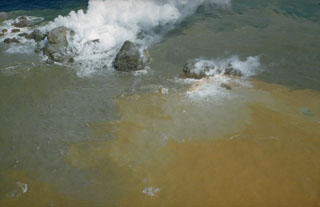Report on Myojinsho (Japan) — November 1980
Scientific Event Alert Network Bulletin, vol. 5, no. 11 (November 1980)
Managing Editor: David Squires.
Myojinsho (Japan) Discolored water
Please cite this report as:
Global Volcanism Program, 1980. Report on Myojinsho (Japan) (Squires, D., ed.). Scientific Event Alert Network Bulletin, 5:11. Smithsonian Institution. https://doi.org/10.5479/si.GVP.SEAN198011-284070
Myojinsho
Japan
31.888°N, 139.918°E; summit elev. 11 m
All times are local (unless otherwise noted)
The crew of the fishing boat Suitenmaru 11 saw discolored water over Myojin-sho on 15 November at around 1530. They reported that no discoloration had been seen there that morning. JMSA personnel flew over the site on 18 November and observed three circular areas of pale green water, each 50-80 m across, aligned within a 300-m zone. [Discolored water was] also seen the following day by the crew of the fishing boat Shinkomaru 26 and again by JMSA personnel on 26 November. No floating ejecta or upwelling of water were noted, however.
Geological Summary. Beyonesu Rocks are part of the barely exposed rim of the largely submarine Myojinsho caldera. Formation of the 8-9 km wide caldera was followed by construction of a large (2.6 km3) lava dome and/or lava flow complex on the caldera floor, originally located at a depth of 1,000-1,100 m. Most eruptions recorded since the late-19th century have occurred from the dacitic post-caldera Myojinsho lava dome on the NE caldera rim. Deposits from submarine pyroclastic flows associated with growth of the dome cover it and extend both into the NE part of the caldera and down its outer slopes. An explosive submarine eruption from Myojinsho in 1952 destroyed a Japanese research vessel, killing all 31 on board. Submarine eruptions have also been observed from other points on the caldera rim and outside of the caldera. The Beyonesu Rocks were named after the French warship the Bayonnaise, which was surveying volcanic islands south of Tokyo Bay in 1850.
Information Contacts: JMSA, Tokyo; JMA, Tokyo.

